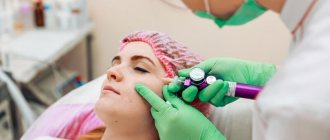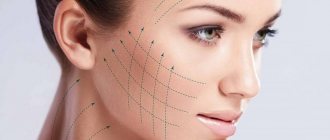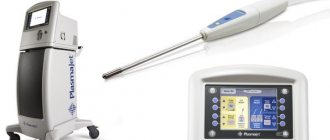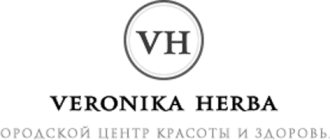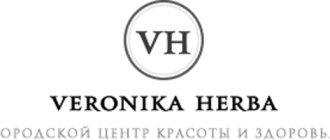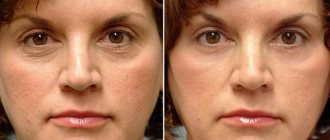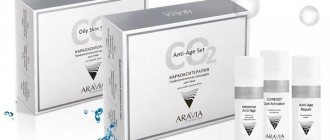Non-invasive carboxytherapy is a technique for restoring intracellular respiration of the skin! It is a non-injection transdermal injection of carbon dioxide under the skin. A special product is applied to the skin, which contains carbon dioxide molecules obtained by mixing certain ingredients.
With age, skin trophism deteriorates significantly, vascular tone and, accordingly, oxygen saturation of tissues decrease.
The program includes the use of the original mask. The main component of this mask is carbon dioxide. Carbon dioxide is formed as a result of mixing the components of the active mask: granules and gel. Molecular CO2 very quickly penetrates the epidermis of the skin and reaches the blood vessels, due to which there is an instant dilation of blood vessels, increased blood circulation, and an influx of oxygen and nutrients to the skin cells. This process stimulates collagen production, which provides a natural face lift (lifting), improving the color and appearance of the skin.
How is non-invasive carboxytherapy performed in the salon?
After examining the client’s skin, identifying skin problems and the presence of contraindications, the cosmetologist in Krasnodar cleanses the skin. After preparing the patient's skin, a carboxytherapy mask is applied. Carboxy face mask can be fabric or gel, depending on the manufacturer. Carboxytherapy kits that contain both a gel and an activator mask are popular. Their manufacturer is mainly Korea.
The variety of masks for carboxytherapy without injections on the Russian market of cosmetic products is great. Here you will find both professional lines and those suitable for home use. The most popular and effective carboxytherapy face masks are produced by the following companies:
- Arabia;
- Gigi;
- Dermatime;
- Demax.
The process of applying a carboxy mask to the skin of the face is absolutely comfortable for the client. For 10 minutes, the cosmetologist works on the mask with pressing movements to maximize the saturation of the skin with CO2 molecules. Non-injection carboxytherapy also has the effect of light skin peeling.
After all areas have been treated, the carboxy face mask is left on for another 20 minutes to trigger collagen synthesis, achieve a lifting effect and smooth out fine wrinkles. After which the mask is removed, and the remaining gel is washed off with water.
Carbon dioxide in the non-invasive carboxytherapy kit for the face and neck has a lipolytic effect and will help get rid of a double chin.
To achieve maximum effect, a course of non-injection carboxytherapy is required, consisting of 4 to 8 procedures with an inter-procedure interval of 7 days. Further, it is recommended to carry out 1 procedure per month to maintain the results obtained.
One of the advantages of the procedure is that non-injection carboxytherapy does not leave any redness or irritation on the skin after use, and the skin is absolutely calm.
Within three days after the carboxy facial procedure, the skin is most permeable to nourishing creams and masks for skin problems. You can achieve a brightening effect, apply an anti-pigmentation serum or an alginate mask for skin problems.
A little history of carboxytherapy
Injection Carboxytherapy is a dosed injection of carbon dioxide (CO2) intradermally or subcutaneously in the projection of various parts of the face and body for preventive and therapeutic purposes.
These procedures are carried out using special equipment. The carboxytherapy method has proven itself over time and is based on the experience gained in sanatorium treatment, where it was first used in 1932 in the French resort of Royat.
In the Czech Republic, carboxytherapy has been successfully used for more than 50 years in famous resorts: Karlovy Vary, Marianske Lazne, Frantiskovy Lazne.
By the way, the main contingent of Karlovy Vary are our compatriots, many of whom come from year to year for therapeutic “gas injections,” as Czech doctors call them.
The first most popular treatments using carboxytherapy are diseases of the musculoskeletal system, such as: arthritis, arthrosis, pain syndromes in joints and muscles, fasciitis, tendonitis, spinal osteochondrosis, including the stages of protrusion and disc herniation.
No less popular is the treatment of various circulatory disorders: lymphatic and venous edema, varicose veins and signs of chronic venous insufficiency, as well as trophic ulcers and diabetic wounds. Carboxytherapy can be used as monotherapy, but the best effect will be achieved in an integrated approach with other procedures.
General health carboxytherapy includes natural carbon dioxide mineral springs, artificial carbon dioxide baths, special devices “dry carbon dioxide baths,” and injection of CO2.
In the 60s of the 20th century, resorts in Europe (Czech Republic, Slovakia, France, Germany, Russia) began to create and use special therapeutic devices or “dry” baths, which were filled with carbon dioxide of varying concentrations.
Dry carbon dioxide baths lower blood pressure, normalize the state of the central nervous system, increase the amount of oxygen in arterial blood, and improve all metabolic processes in the body - carbohydrate, fat, protein, electrolyte.
Currently, carbotherapy is a medical technology, adapted and successfully used in dermatology and cosmetology for the treatment of various dermatoses, improving the quality of the skin and its restoration after damage, as well as in anti-aging medicine.
International congresses dedicated to anti-aging medicine actively promote the carboxytherapy method as the least aggressive and most comfortable for patients, with excellent results and without the risk of side effects.
In Europe, scientific research on this method is carried out by: the University of the Italian city of Siena, the Center for Microangiology and Microcirculation at the University of Milan, branches in Austria and Hungary.
In countries such as Australia, Korea, Singapore, and South American countries, carboxytherapy is used in many areas of medicine.
In Japan, carboxytherapy is actively used to heal trophic ulcers in diabetic feet, including in older patients. It was noted that healing occurs with the formation of a minimal scar. Also in the treatment of burn patients.
In Russia, this method is gaining wide popularity among multidisciplinary medical centers, sanatoriums, cosmetology clinics, centers for the treatment of the musculoskeletal system and aesthetic medicine.
Non-invasive carboxytherapy ECO2 GEL THERAPY NeoChemir
NeoChemir was founded in May 2001. The company's headquarters are located in Japan in Minato-ku District, Kobe.
NeoChemir works closely with five departments at Kobe and Osaka Research Universities.
One of the main achievements of the company's research department was the development of DDS technology for transporting therapeutic substances using hydrogels and non-invasive carboxytherapy eCO2-Gel Therapy.
This carboxytherapy system is the only one in the world and has a huge evidence base - numerous officially registered research works, tests and experiments.
This is a patented and only system in the world for delivering CO2 to tissue to a depth of 2 to 7 cm.
This brand is the result of numerous studies and experiments, during which it was revealed not only the therapeutic effect of CO2 on healing processes, but also amazing results when the CO2 system is exposed directly to the skin.
The essence of the procedure
The active element of carboxytherapy is sterile carbon dioxide. It is administered intradermally or subcutaneously. In response to hypercapnia, nearby vessels reflexively dilate, the supply of oxygen to the tissue increases, and blood flow increases. As a result, fibroblasts are activated - cells responsible for the synthesis of collagen and elastin fibers.
- Skin turgor increases, it thickens and tightens, becomes smoother;
- removal of toxic substances, suppression of pathogenic bacteria and other pathogens has a beneficial effect on the health of the dermis: it is cleared of rashes and becomes less irritated;
- the level of moisture and acid-base balance is restored, thereby slowing down skin aging.
Carboxytherapy is applicable for various types of skin, has few contraindications, and is well tolerated. Only a few treatments are required to achieve visible results.
Properties of CO2 in the body
- Carbon dioxide is a colorless gas with two oxygen atoms and one carbon atom, odorless, one and a half times heavier than air.
- It is a normal component of the atmosphere, where it is detected in minimal quantities in the air, and in sufficient quantities in mineral water.
- It appears as the end product of biological processes: respiration, fermentation or as a result of the combustion of coal fuel.
- It has increased solubility compared to oxygen.
- Produced by cells, maintains acid-base balance and affects protein formation, cell membrane permeability, hormone synthesis and the state of the nervous, hematopoietic, and excretory systems.
- The body contains 7% CO2, which is produced in the amount of 1 kg per day and is an internal product of metabolic processes.
- It is also found in a dissolved state in blood cells - erythrocytes in the form of carbonic acid salts.
- It is distributed through the venous system and exhaled by the lungs, where the concentration of the component decreases while controlling the body's defenses.
- It is interconnected as a result of transport by hemoglobin with oxygen, with which it is in a 3:1 ratio, which creates normal conditions for the life of the body.
- When used medically, it is absorbed into the body and eliminated after 30 minutes, therefore it is absolutely and naturally safe.
Contraindications and adverse reactions
You will have to refuse a cosmetic procedure with carbon dioxide in case of severe neurological pathologies, after a heart attack or stroke, in case of blood clotting disorders, in case of cancer, in case of acute infectious diseases, or exacerbations of any chronic pathologies. Pregnant and lactating women should also not undergo carboxytherapy. Injections are prohibited for neoplasms or skin lesions at the injection sites.
During a non-injection therapy session, a slight crackling sound may be heard and a slight tingling sensation may be felt on the skin. After the procedure, short-term irritation reactions are possible:
- swelling;
- redness;
- slight burning sensation;
- slight soreness.
Due to active blood circulation, acne and pustules may appear in the first few days after the first sessions. The listed symptoms are a normal reaction of the body. They all go away on their own within 2–3 days.
Positive effects
Carboxytherapy is a safe method of rejuvenating the skin of the face, neck, hips and other parts of the body. Violation of the integrity of the skin is not a side effect of the procedure, since cosmetologists use topical products instead of needles. Many of the positive properties of this therapy are not immediately noticeable, but within a few hours after applying the mask, a woman can see results.
Key effects:
- Restoration of blood flow in the surface epithelium. As a result, the stratum corneum begins to renew itself faster.
- Strengthening oxidative processes in cells. The additional amount of energy required by tissues to perform important functions is released.
- Stimulation of synthetic processes. The cells produce more protein, which is necessary to maintain the strength and elasticity of the skin.
- Cleansing. Dilated vessels remove harmful metabolic products from the epithelium.
The oxygen saturation technique is useful for any skin type. A consultation with a cosmetologist in Moscow will help the patient clarify the conditions of the procedure and prices. You can read reviews in advance on the Internet.
The effect of hypoxia on the skin
The main consumers of oxygen are the brain, kidneys, and liver. Of course, they are primarily supplied with blood and oxygen.
When there is a lack of oxygen, the skin is the last to receive it.
- Cell division slows down and physiological renewal in the epidermis and dermis is disrupted, which provokes deterioration of color (asphyxtic skin), loss of skin turgor, and impaired melanogenesis.
- Chronic hypoxia or the entry of oxygen into the skin from air contaminated with various pollutants activates the production of free radicals that trigger an inflammatory cascade, disruption of angiogenesis, skin microflora, and accelerated aging.
- Lack of oxygen in the skin affects the activity of various biochemical processes, weakening the barrier and thermoregulatory functions of the skin, leading to dysregulation of the immune response and premature aging.
- Cell division slows down and physiological renewal in the epidermis and dermis is disrupted; complete oxidation of organic substances does not occur and, when accumulated, they cause intoxication.
- Keratinocytes produce insufficient amounts of ceramides, structural proteins (involucrin, loricrin, filaggrin), pro-inflammatory mediators (chemokines, cytokines), leading to dry skin, disruption of its barrier properties, negatively affecting its relief and color.
- In the dermis, when cells are starved of oxygen, aggregates of collagen and elastin fibers accumulate, the structure of the matrix changes, leading to a decrease in the elasticity and turgor of the skin, and the appearance of wrinkles.
Ozone therapy
Treatment with this technique is based on the use of ozone for medical and cosmetic purposes. The gas is administered intravenously, subcutaneously, intradermally, or applied to the skin as part of cosmetic products. When administered intravenously, the ozone-oxygen mixture is enriched with saline solution or the patient’s blood.
Ozone is an oxidizing agent with powerful disinfectant properties, which is why it is widely used in medicine. It improves blood composition, removes toxins, kills harmful microbes, fungi and viruses. Ozone also strengthens the immune system and saturates cells with oxygen. As a result, overall well-being, mood, stress resistance, and performance improve. The liver removes toxins better after a course of procedures, the kidneys work better, the joints become healthier, and the intensity of the pain syndrome decreases.
Ozone is in demand in cosmetology because it triggers regeneration processes in the body, stimulates the production of elastin and collagen in the skin, breaks down and removes fatty tissue, helps against cellulite and allows you to correct your figure.
You can undergo the ozone therapy procedure in our clinic at the address: St. Petersburg, st. Bolshaya Raznochinnaya, 27 metro station Chkalovskaya.
Indications
Let's consider indications for different fields - medicine and cosmetology.
In medecine:
- gastrointestinal diseases;
- allergy;
- viruses;
- venereal diseases;
- diseases related to gynecology;
- dermatological pathologies;
- problems with blood vessels;
- various spinal lesions;
- diseases of the genitourinary system;
- low resistance to stress;
- poor general health;
- sleep problems;
- weak immunity;
- varicose veins;
- vascular network on the legs.
For cosmetology:
- dandruff, hair loss;
- cellulite;
- age-related changes;
- acne;
- stretch marks, scars;
- skin pigmentation disorder;
- rehabilitation period after liposuction, peeling;
- preparation for peeling;
- swelling of the face;
- dark circles and bags under the eyes;
- vascular network on the face;
- rosacea;
- local deposits of fat on the hips, abdomen, buttocks, waist;
- comedones;
- problematic skin;
- seborrhea;
- fungal skin infections;
- double chin;
- low elasticity and dry skin.
Contraindications
General contraindications for medicine and cosmetology:
- individual intolerance to ozone;
- thyroid diseases;
- alcohol intoxication;
- pancreatitis;
- blood clotting disorder;
- hyperthyroidism;
- heart disease in the acute phase;
- hemophilia;
- tendency to seizures;
- internal bleeding;
- diabetes.
What problems can ozone therapy solve?
A course of procedures will solve the problem of cellulite, enlarged pores, stretch marks, and sagging skin. It is used when there is a threat of miscarriage, to treat various inflammations, prevent aging, accelerate the recovery process after surgery, and treat burns. Ozone improves health, strengthens the immune system, and serves as a preventative against the influenza virus.
Indications for use
This is a large list of cosmetic problems:
- drooping of facial tissues - ptosis;
- double chin;
- deterioration of skin color, circles under the eyes, hyperpigmentation;
- acne, acne, psoriasis;
- mimic and age wrinkles, stretch marks;
- swelling;
- rosacea: spider veins, redness;
- hair loss;
- cellulite;
- oily seborrhea.
On the abdomen, sides and buttocks, the procedure allows you to remove local fat deposits, remove swelling, draw muscle relief, improve lymph flow, smooth out the “orange peel”, reduce stretch marks, tighten sagging skin after losing weight.
Carboxytherapy is prescribed to adult patients: from 18 years of age. Its effectiveness is high in young, mature and old age.
Kinds
Non-invasive carboxytherapy is a transdermal method of saturating the skin with carbon dioxide using special means - a mask with the main component - a carbon dioxide molecule and additional substances: hyaluronic, fruit acids, vitamins, plant extracts to increase nutrition and hydration of cells. The technique does not damage the barrier functions of the skin and does not injure soft tissues.
MESOMATRIX non-invasive carboxytherapy systems - for aging skin and problem skin.
Invasive carboxytherapy is the intra- and subcutaneous injection of carbon dioxide using a special device with thin needles for renewing and rejuvenating effects. Manipulation is popular as it provides long-lasting healing results and rapid delivery of gas to the points of influence.
How can carboxytherapy restore youth and stop aging?
There are many skin types, and we all age differently. And no matter how you care for your skin, time will still take its toll. You can achieve excellent results by maintaining skin elasticity with collagen. This in turn will prevent sagging of softer tissues and muscles. According to the new concept, it is necessary to begin facelift procedures as early as possible to avoid, or at least postpone, surgical intervention. It is recommended to conduct a course of 4-6 procedures annually with a break of 2-4 weeks.
What should you expect before and after carboxytherapy?
The sensations during the procedure can be compared to slight pulsation or pressure. Minor discomfort usually lasts 2-4 minutes. Carbon dioxide is 20 times more soluble than oxygen, so it spreads easily and quickly from the injection site to nearby tissues. After administration, the gas will be absorbed within 5 minutes, and swelling and slight redness will appear. This process of inflammation will trigger the production of collagen.
The procedure is not accompanied by pain. There may be a slight feeling of tension under the skin as gas is released. The injection site should not be wet for 4 hours. The only side effect may be a bruise if the needle gets into the vessel. However, this only happens in 2% of patients. There is no recovery period.
